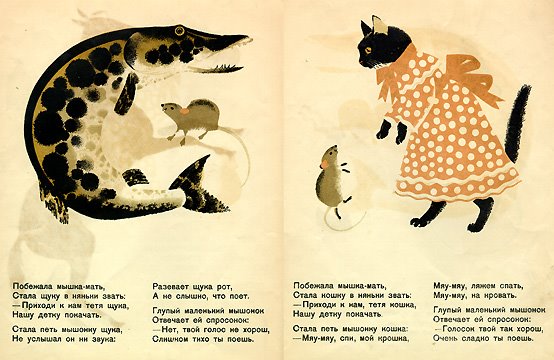Russian graphic artist, painter and illustrator Vladimir Vasil'evich Lebedev (1891-1967) gave rise
to the cutting-edge Leningrad school of illustrated children’s books during the Soviet era
His creative collaboration with poet, author and translator Samuil Yakovlevich Marshak (1887-1964)
brought together the innovative talents of two extraordinary artists. Lebedev was art editor of
the state publishing house Gosizdat (later Detgiz) from 1924 to 1933, while Marshak was its editor-in-chief.
Marshak had a talent for educating children about the Soviet Socialist ideas without sounding
too pompous or preachy. The eclectic Lebedev had worked as a poster artist during the Civil War,
and his early work combined the influences of Cubism and lubok folk prints.
Together they gave birth to almost fifty titles, many of them classics often republished
and familiar to several generations of Russian children.
Slonyonok (The Elephant's Child, 1922)
Lubodev's geometrically shaped illustrations for Rudyard Kipling's The Elephant's Child made
an enormous impression on artists and critics as a revolutionary work of Constructivist
graphic art and became the manifesto of a new approach to childrens' book illustration.
At first, most children were not as impressed by Lebedev's flattened and schematic representations.
In a survey by The Bulletin of the Children's Reading Institute Review Commission (!), they complained
that the stencil-like gaps irritated them, and were disturbed by the seemingly cut up and torn apart
animal shapes. This shows how unconventional Lubodev's illustrative approach was at the time.
O glupom myshonke (A silly mouse, 1925)
Bagazh (The Luggage, 1926)
Pudel' (The Poodle, 1927)
WIth Pudel',Lebedev first developed a new impressionistic style, more spontaneous and free.
Skazki, pesni, zagadki (Fairy Tales, Songs, Riddles, 1935)
One of the drawings that came under ideological criticism.
In 1936, together with artist Vladimir Konashevich, Lebedev became the victim of a Stalinist
diffamatory campaign. The two were violently criticized for the avant-garde style of their illustrations.
In 1937 Detgiz was closed down, and many of its authors and editors were arrested and sent to Gulags.
Marshak and Lebedev were lucky to survive; the first made a narrow escape to Moscow,
while the latter changed his illustrative style to realistic and never again exhibited as a painter.










Laura, these works are exquisite. And what a story behind them. Thanks for authoring and sharing this!
ReplyDeleteThanks Amy, I really enjoy these Russian illustrators too! There are a few more I want to post about when I am back from vacation...
ReplyDeleteI love russian illustrators too - great post - I was going to write about something similar myself...
ReplyDeleteGreat post!
ReplyDeletei like this illustration!
i read you often from now